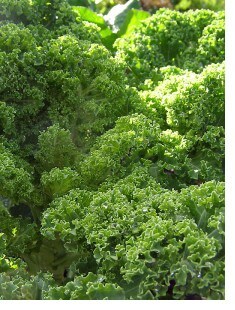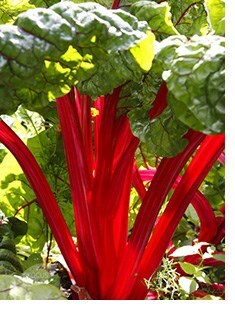Toughest veg for our crazy climate!

It is a source of wonder to me that in my poor battered veg garden, awash with rainwater and gloopy with mud, there are still things I can harvest in March. Not much, it’s true, but enough to keep the Sunday roasts chugging out of the oven and offer a few home-grown ingredients for ersatz midweek meals.
Most veg suffer in some sort of weather extreme. Anything that flowers or fruits, including peas and beans, are sporadic at best in gloomy, chilly summers. Extreme cold sends heat-lovers like sweetcorn, squash and courgettes into shivering paralysis; warm, wet winters rot otherwise hard-as-nails rhubarb crowns, put paid to your crops of blackcurrants, strawberries and apples, and give you disappointing garlic bulbs that more often than not haven’t bothered to split into cloves. And heat sends most leafy crops bolting for the skies.
So what’s a girl to do in a world where the climate is changing to the point of unrecognizability? The one thing that’s absolutely certain is that nobody knows what’s in store for us next. It could be a tomato summer of the hosepipe ban and shade netting variety; or a lettuce summer with 2012 levels of dampness and general depression (god forbid).
Well, if it’s guarantees you want, plant this lot. They’re my real troopers: the ones which survive no matter what, even through the winter of 2010/2011, when the drifts of snow were so deep the only reason I knew I had a veg garden was the gentle dip between two hedges. When it finally melted (with accompanying floods), these were the ones still standing, still productive and only a little bit battered.
They’re year-rounders, too, a constant background presence in my garden through spring, summer and winter. And if you remember, last summer was a bit of a scorcher. In my chalky, free-draining garden it gets pretty dry quite quickly given a bit of sunshine: lettuces bolted, rocket laughed at the idea of producing leaves and went straight to the seedpod stage, and as for spinach – I may as well not have bothered planting it. This lot carried on regardless, good-naturedly staying leafy and productive instead of panicking and sending up flower spikes. They didn’t even need that much extra watering.
 They’re not the most exciting veg. Most of them don’t flower or have fruit or do anything particularly spectacular. But anything that can survive a Noah’s Ark standard flooding, a three month drought and a mini ice age is my idea of rock-solid reliable. These are the ultimate climate change proof veg, and if you’re left dithering over what to grow in the face of ever more unpredictable weather, these should be top of your list.
They’re not the most exciting veg. Most of them don’t flower or have fruit or do anything particularly spectacular. But anything that can survive a Noah’s Ark standard flooding, a three month drought and a mini ice age is my idea of rock-solid reliable. These are the ultimate climate change proof veg, and if you’re left dithering over what to grow in the face of ever more unpredictable weather, these should be top of your list.
Kale: not all kales are equal in the climate change stakes. Cavolo Nero (aka Tuscan kale) doesn’t take kindly to deep freezes, for example, and Red Russian is battered and shredded by gales. But Dwarf Green Curled and Redbor are almost completely indestructible.
Chard: as climate change takes hold I’m beginning to wonder if anyone will ever bother growing weather-sensitive spinach again, especially when you’ve got just-as-good chard to hand. Again, choose varieties carefully. Coloured and red-stemmed ‘Rhubarb’ types need protection in a rough winter and in a really bad one may just give it up as a bad job. White-stemmed ones, on the other hand, are tough as they come, weathering ice, gales and snow with a breezy insouciance. They even store water in those fleshy midribs, making them reliably drought-resistant too.
American land cress: I grew this as a replacement for watercress a couple of years ago, and it’s been with me ever since. It looks just like watercress but grows happily in quite dry soils – it just gets more peppery. Give it deluges of water and it romps away: freeze it solid and it just looks pretty and then carries on growing once it’s thawed again. It’s an invaluable and plentiful salad ingredient, and once planted, you’ll have it forever.
Corn salad: If you don’t like your salad ingredients peppery, rosettes of fleshy, mid-green cornsalad leaves are the closest you’ll get to lettuce without the tendency to bolt in warm weather or rot to rags in the cold. Let it self-seed once and clumps of it pop up in unexpected places forevermore. It’s lucky it tastes so good, or you’d call it a weed.
Beetroot: Forget the fancy ones: grow traditional guaranteed performers like ‘Boltardy’ for root veg you can grow all year round, surviving temperatures from -10°C to +30°C without shrivelling to nothing or erupting into flower. The roots may be smaller and woodier in drier weather, but if that happens just eat the leaves instead: they’re a lovely earthy mildly beetrooty version of spinach.




 They’re not the most exciting veg. Most of them don’t flower or have fruit or do anything particularly spectacular. But anything that can survive a Noah’s Ark standard flooding, a three month drought and a mini ice age is my idea of rock-solid reliable. These are the ultimate climate change proof veg, and if you’re left dithering over what to grow in the face of ever more unpredictable weather, these should be top of your list.
They’re not the most exciting veg. Most of them don’t flower or have fruit or do anything particularly spectacular. But anything that can survive a Noah’s Ark standard flooding, a three month drought and a mini ice age is my idea of rock-solid reliable. These are the ultimate climate change proof veg, and if you’re left dithering over what to grow in the face of ever more unpredictable weather, these should be top of your list.